Strategic Marketing Reflection Report: Personal Characteristics Impact
VerifiedAdded on 2021/02/20
|6
|1681
|15
Report
AI Summary
This report offers a comprehensive reflection on a strategic marketing assignment. It begins with a description of the team environment, highlighting communication tools and time management strategies. The report then delves into the author's individual characteristics, including risk aversion, maximizing tendencies, and procrastination levels, and assesses their impact on team interactions using Belbin's theory. The author discusses their decision-making style, analyzes the implications for future professional life, and identifies areas for personal improvement. The report also references Tuckman's team development model and the impact of individual roles within a team, providing insights into effective teamwork and strategic marketing principles. Several self-assessment surveys and their results are included to provide a holistic view of the author's approach.
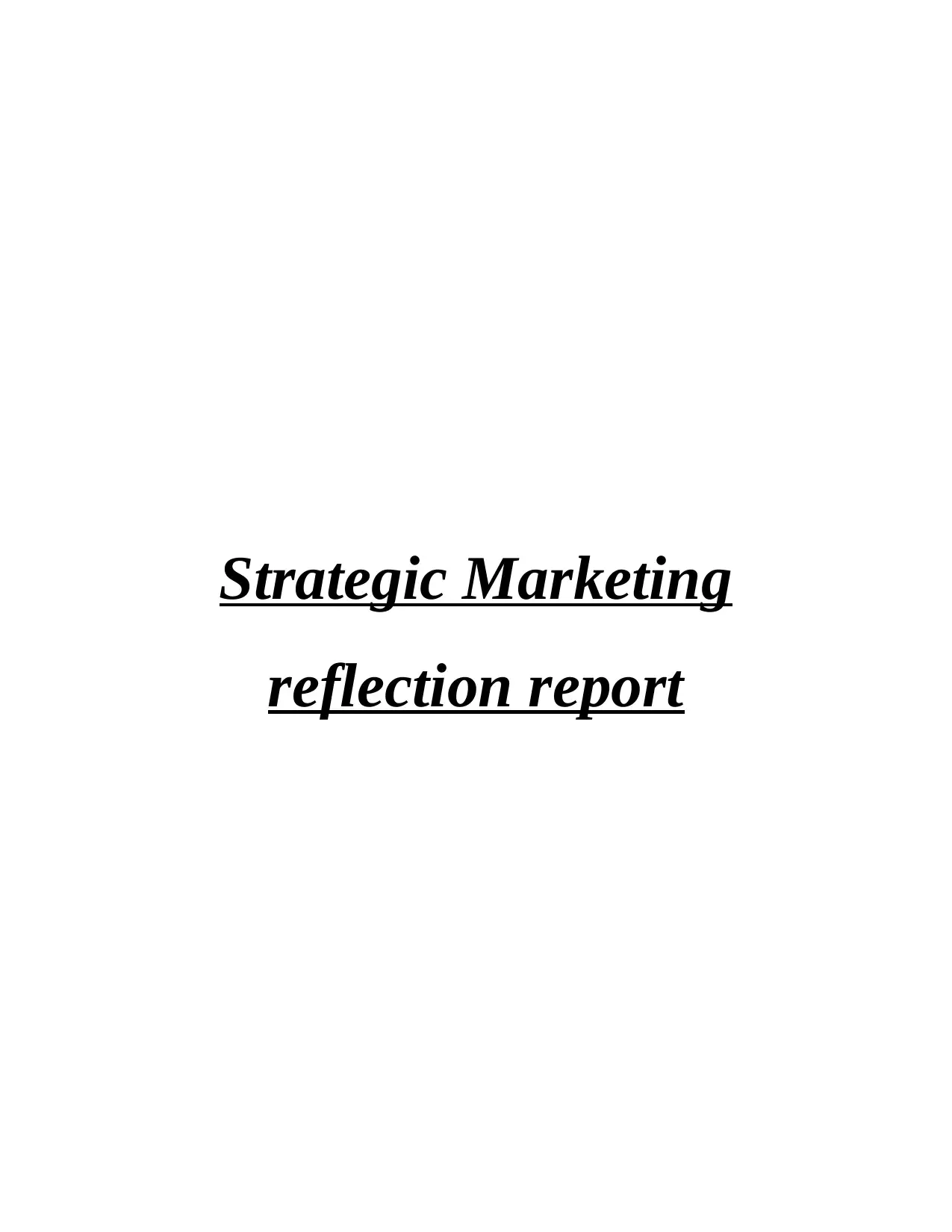
Strategic Marketing
reflection report
reflection report
Paraphrase This Document
Need a fresh take? Get an instant paraphrase of this document with our AI Paraphraser
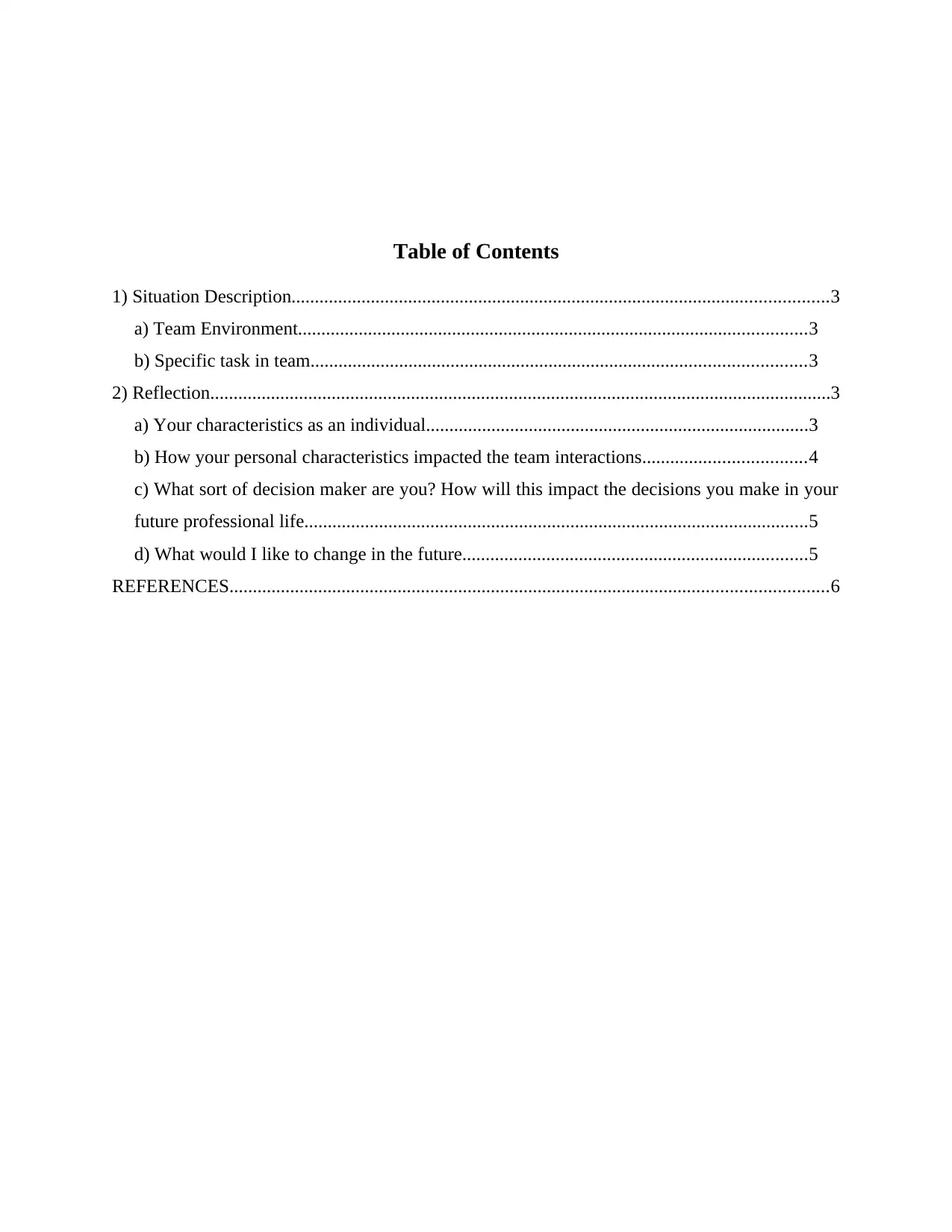
Table of Contents
1) Situation Description...................................................................................................................3
a) Team Environment.............................................................................................................3
b) Specific task in team..........................................................................................................3
2) Reflection.....................................................................................................................................3
a) Your characteristics as an individual..................................................................................3
b) How your personal characteristics impacted the team interactions...................................4
c) What sort of decision maker are you? How will this impact the decisions you make in your
future professional life............................................................................................................5
d) What would I like to change in the future..........................................................................5
REFERENCES................................................................................................................................6
1) Situation Description...................................................................................................................3
a) Team Environment.............................................................................................................3
b) Specific task in team..........................................................................................................3
2) Reflection.....................................................................................................................................3
a) Your characteristics as an individual..................................................................................3
b) How your personal characteristics impacted the team interactions...................................4
c) What sort of decision maker are you? How will this impact the decisions you make in your
future professional life............................................................................................................5
d) What would I like to change in the future..........................................................................5
REFERENCES................................................................................................................................6
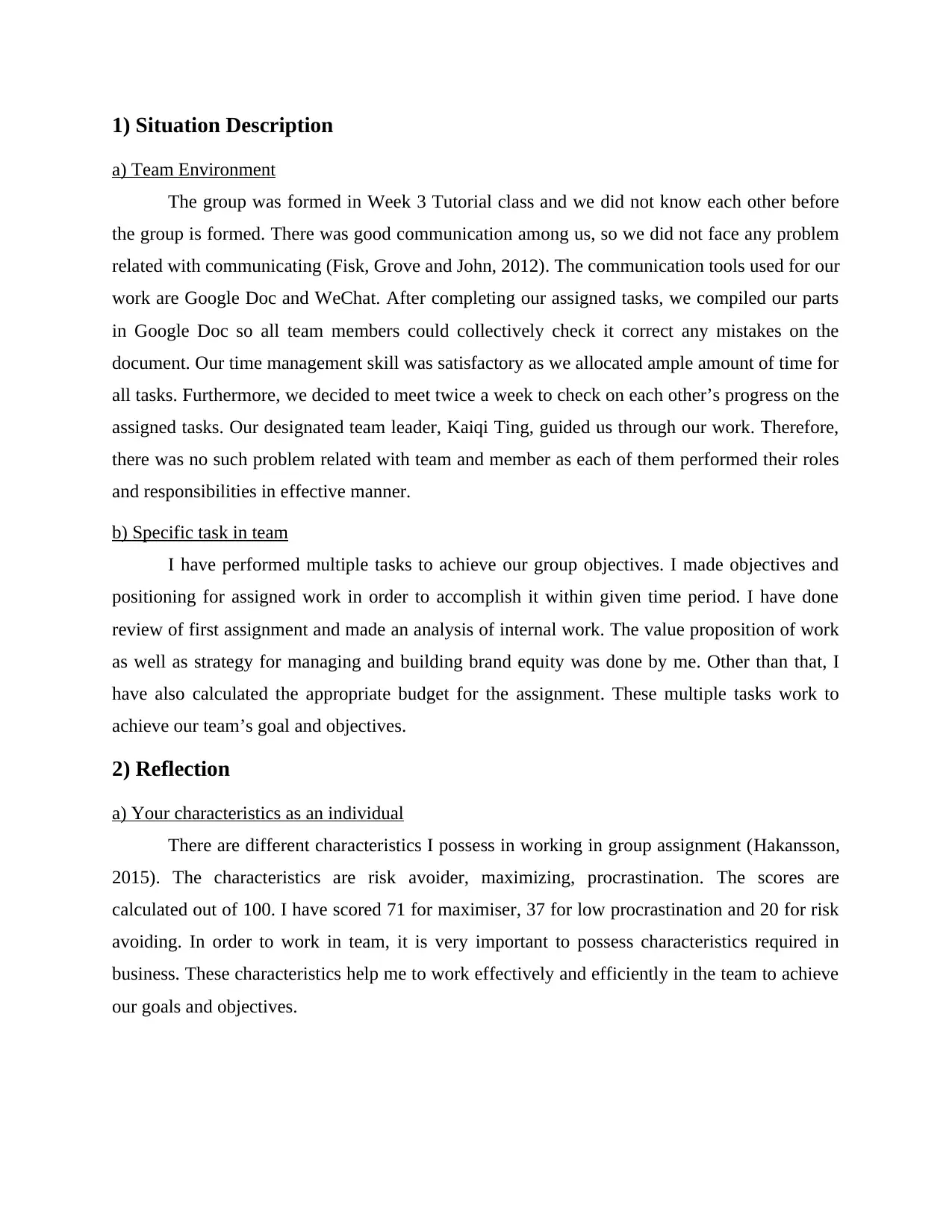
1) Situation Description
a) Team Environment
The group was formed in Week 3 Tutorial class and we did not know each other before
the group is formed. There was good communication among us, so we did not face any problem
related with communicating (Fisk, Grove and John, 2012). The communication tools used for our
work are Google Doc and WeChat. After completing our assigned tasks, we compiled our parts
in Google Doc so all team members could collectively check it correct any mistakes on the
document. Our time management skill was satisfactory as we allocated ample amount of time for
all tasks. Furthermore, we decided to meet twice a week to check on each other’s progress on the
assigned tasks. Our designated team leader, Kaiqi Ting, guided us through our work. Therefore,
there was no such problem related with team and member as each of them performed their roles
and responsibilities in effective manner.
b) Specific task in team
I have performed multiple tasks to achieve our group objectives. I made objectives and
positioning for assigned work in order to accomplish it within given time period. I have done
review of first assignment and made an analysis of internal work. The value proposition of work
as well as strategy for managing and building brand equity was done by me. Other than that, I
have also calculated the appropriate budget for the assignment. These multiple tasks work to
achieve our team’s goal and objectives.
2) Reflection
a) Your characteristics as an individual
There are different characteristics I possess in working in group assignment (Hakansson,
2015). The characteristics are risk avoider, maximizing, procrastination. The scores are
calculated out of 100. I have scored 71 for maximiser, 37 for low procrastination and 20 for risk
avoiding. In order to work in team, it is very important to possess characteristics required in
business. These characteristics help me to work effectively and efficiently in the team to achieve
our goals and objectives.
a) Team Environment
The group was formed in Week 3 Tutorial class and we did not know each other before
the group is formed. There was good communication among us, so we did not face any problem
related with communicating (Fisk, Grove and John, 2012). The communication tools used for our
work are Google Doc and WeChat. After completing our assigned tasks, we compiled our parts
in Google Doc so all team members could collectively check it correct any mistakes on the
document. Our time management skill was satisfactory as we allocated ample amount of time for
all tasks. Furthermore, we decided to meet twice a week to check on each other’s progress on the
assigned tasks. Our designated team leader, Kaiqi Ting, guided us through our work. Therefore,
there was no such problem related with team and member as each of them performed their roles
and responsibilities in effective manner.
b) Specific task in team
I have performed multiple tasks to achieve our group objectives. I made objectives and
positioning for assigned work in order to accomplish it within given time period. I have done
review of first assignment and made an analysis of internal work. The value proposition of work
as well as strategy for managing and building brand equity was done by me. Other than that, I
have also calculated the appropriate budget for the assignment. These multiple tasks work to
achieve our team’s goal and objectives.
2) Reflection
a) Your characteristics as an individual
There are different characteristics I possess in working in group assignment (Hakansson,
2015). The characteristics are risk avoider, maximizing, procrastination. The scores are
calculated out of 100. I have scored 71 for maximiser, 37 for low procrastination and 20 for risk
avoiding. In order to work in team, it is very important to possess characteristics required in
business. These characteristics help me to work effectively and efficiently in the team to achieve
our goals and objectives.
⊘ This is a preview!⊘
Do you want full access?
Subscribe today to unlock all pages.

Trusted by 1+ million students worldwide
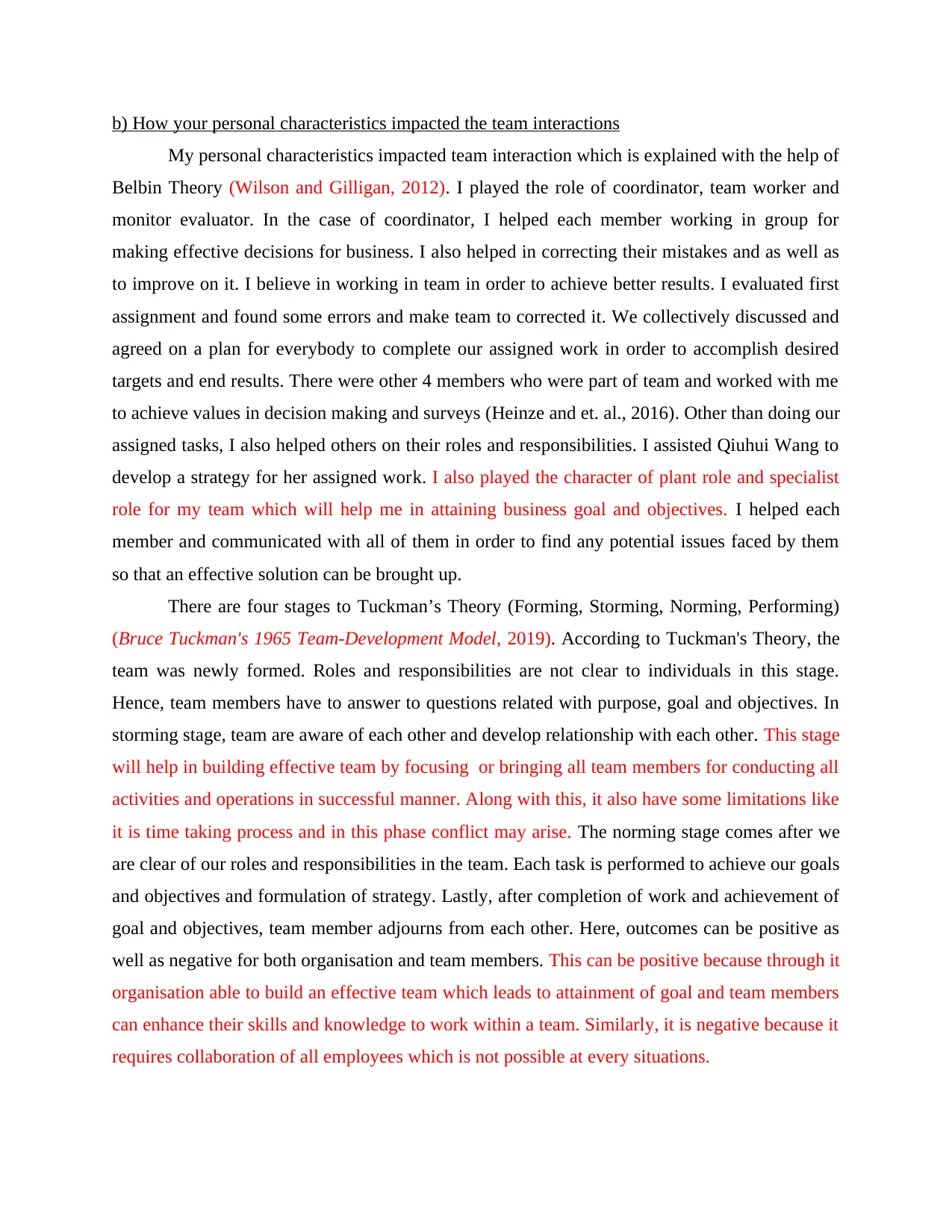
b) How your personal characteristics impacted the team interactions
My personal characteristics impacted team interaction which is explained with the help of
Belbin Theory (Wilson and Gilligan, 2012). I played the role of coordinator, team worker and
monitor evaluator. In the case of coordinator, I helped each member working in group for
making effective decisions for business. I also helped in correcting their mistakes and as well as
to improve on it. I believe in working in team in order to achieve better results. I evaluated first
assignment and found some errors and make team to corrected it. We collectively discussed and
agreed on a plan for everybody to complete our assigned work in order to accomplish desired
targets and end results. There were other 4 members who were part of team and worked with me
to achieve values in decision making and surveys (Heinze and et. al., 2016). Other than doing our
assigned tasks, I also helped others on their roles and responsibilities. I assisted Qiuhui Wang to
develop a strategy for her assigned work. I also played the character of plant role and specialist
role for my team which will help me in attaining business goal and objectives. I helped each
member and communicated with all of them in order to find any potential issues faced by them
so that an effective solution can be brought up.
There are four stages to Tuckman’s Theory (Forming, Storming, Norming, Performing)
(Bruce Tuckman's 1965 Team-Development Model, 2019). According to Tuckman's Theory, the
team was newly formed. Roles and responsibilities are not clear to individuals in this stage.
Hence, team members have to answer to questions related with purpose, goal and objectives. In
storming stage, team are aware of each other and develop relationship with each other. This stage
will help in building effective team by focusing or bringing all team members for conducting all
activities and operations in successful manner. Along with this, it also have some limitations like
it is time taking process and in this phase conflict may arise. The norming stage comes after we
are clear of our roles and responsibilities in the team. Each task is performed to achieve our goals
and objectives and formulation of strategy. Lastly, after completion of work and achievement of
goal and objectives, team member adjourns from each other. Here, outcomes can be positive as
well as negative for both organisation and team members. This can be positive because through it
organisation able to build an effective team which leads to attainment of goal and team members
can enhance their skills and knowledge to work within a team. Similarly, it is negative because it
requires collaboration of all employees which is not possible at every situations.
My personal characteristics impacted team interaction which is explained with the help of
Belbin Theory (Wilson and Gilligan, 2012). I played the role of coordinator, team worker and
monitor evaluator. In the case of coordinator, I helped each member working in group for
making effective decisions for business. I also helped in correcting their mistakes and as well as
to improve on it. I believe in working in team in order to achieve better results. I evaluated first
assignment and found some errors and make team to corrected it. We collectively discussed and
agreed on a plan for everybody to complete our assigned work in order to accomplish desired
targets and end results. There were other 4 members who were part of team and worked with me
to achieve values in decision making and surveys (Heinze and et. al., 2016). Other than doing our
assigned tasks, I also helped others on their roles and responsibilities. I assisted Qiuhui Wang to
develop a strategy for her assigned work. I also played the character of plant role and specialist
role for my team which will help me in attaining business goal and objectives. I helped each
member and communicated with all of them in order to find any potential issues faced by them
so that an effective solution can be brought up.
There are four stages to Tuckman’s Theory (Forming, Storming, Norming, Performing)
(Bruce Tuckman's 1965 Team-Development Model, 2019). According to Tuckman's Theory, the
team was newly formed. Roles and responsibilities are not clear to individuals in this stage.
Hence, team members have to answer to questions related with purpose, goal and objectives. In
storming stage, team are aware of each other and develop relationship with each other. This stage
will help in building effective team by focusing or bringing all team members for conducting all
activities and operations in successful manner. Along with this, it also have some limitations like
it is time taking process and in this phase conflict may arise. The norming stage comes after we
are clear of our roles and responsibilities in the team. Each task is performed to achieve our goals
and objectives and formulation of strategy. Lastly, after completion of work and achievement of
goal and objectives, team member adjourns from each other. Here, outcomes can be positive as
well as negative for both organisation and team members. This can be positive because through it
organisation able to build an effective team which leads to attainment of goal and team members
can enhance their skills and knowledge to work within a team. Similarly, it is negative because it
requires collaboration of all employees which is not possible at every situations.
Paraphrase This Document
Need a fresh take? Get an instant paraphrase of this document with our AI Paraphraser
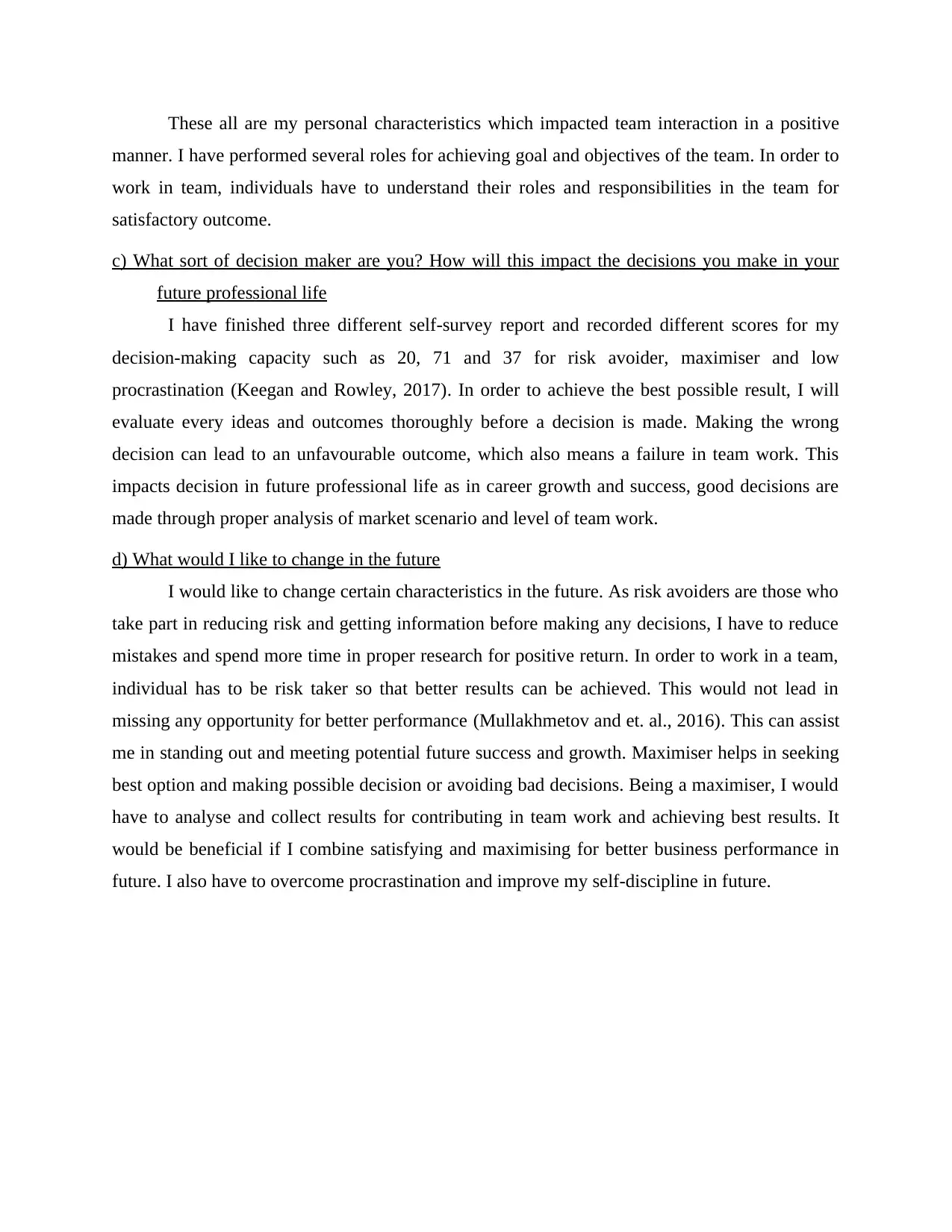
These all are my personal characteristics which impacted team interaction in a positive
manner. I have performed several roles for achieving goal and objectives of the team. In order to
work in team, individuals have to understand their roles and responsibilities in the team for
satisfactory outcome.
c) What sort of decision maker are you? How will this impact the decisions you make in your
future professional life
I have finished three different self-survey report and recorded different scores for my
decision-making capacity such as 20, 71 and 37 for risk avoider, maximiser and low
procrastination (Keegan and Rowley, 2017). In order to achieve the best possible result, I will
evaluate every ideas and outcomes thoroughly before a decision is made. Making the wrong
decision can lead to an unfavourable outcome, which also means a failure in team work. This
impacts decision in future professional life as in career growth and success, good decisions are
made through proper analysis of market scenario and level of team work.
d) What would I like to change in the future
I would like to change certain characteristics in the future. As risk avoiders are those who
take part in reducing risk and getting information before making any decisions, I have to reduce
mistakes and spend more time in proper research for positive return. In order to work in a team,
individual has to be risk taker so that better results can be achieved. This would not lead in
missing any opportunity for better performance (Mullakhmetov and et. al., 2016). This can assist
me in standing out and meeting potential future success and growth. Maximiser helps in seeking
best option and making possible decision or avoiding bad decisions. Being a maximiser, I would
have to analyse and collect results for contributing in team work and achieving best results. It
would be beneficial if I combine satisfying and maximising for better business performance in
future. I also have to overcome procrastination and improve my self-discipline in future.
manner. I have performed several roles for achieving goal and objectives of the team. In order to
work in team, individuals have to understand their roles and responsibilities in the team for
satisfactory outcome.
c) What sort of decision maker are you? How will this impact the decisions you make in your
future professional life
I have finished three different self-survey report and recorded different scores for my
decision-making capacity such as 20, 71 and 37 for risk avoider, maximiser and low
procrastination (Keegan and Rowley, 2017). In order to achieve the best possible result, I will
evaluate every ideas and outcomes thoroughly before a decision is made. Making the wrong
decision can lead to an unfavourable outcome, which also means a failure in team work. This
impacts decision in future professional life as in career growth and success, good decisions are
made through proper analysis of market scenario and level of team work.
d) What would I like to change in the future
I would like to change certain characteristics in the future. As risk avoiders are those who
take part in reducing risk and getting information before making any decisions, I have to reduce
mistakes and spend more time in proper research for positive return. In order to work in a team,
individual has to be risk taker so that better results can be achieved. This would not lead in
missing any opportunity for better performance (Mullakhmetov and et. al., 2016). This can assist
me in standing out and meeting potential future success and growth. Maximiser helps in seeking
best option and making possible decision or avoiding bad decisions. Being a maximiser, I would
have to analyse and collect results for contributing in team work and achieving best results. It
would be beneficial if I combine satisfying and maximising for better business performance in
future. I also have to overcome procrastination and improve my self-discipline in future.
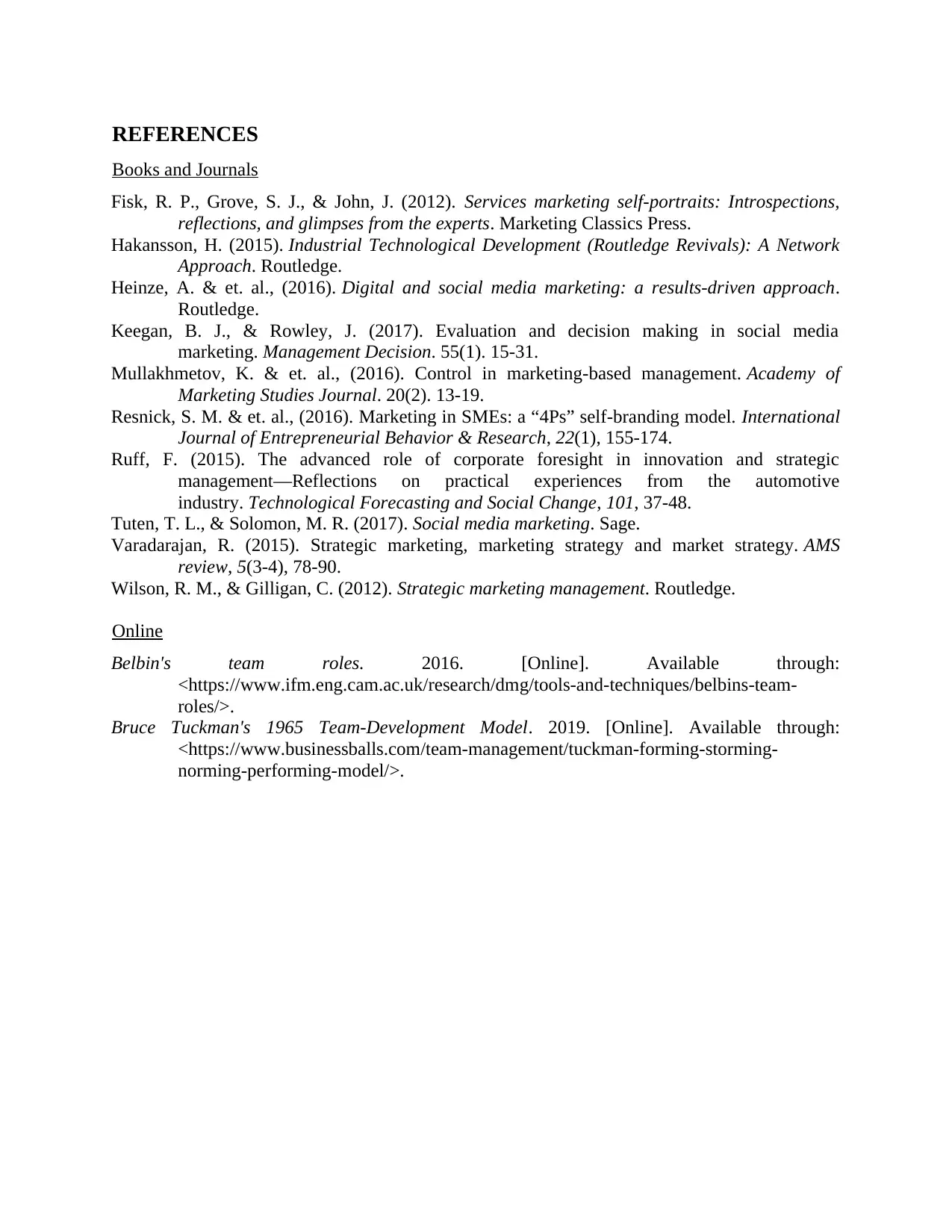
REFERENCES
Books and Journals
Fisk, R. P., Grove, S. J., & John, J. (2012). Services marketing self-portraits: Introspections,
reflections, and glimpses from the experts. Marketing Classics Press.
Hakansson, H. (2015). Industrial Technological Development (Routledge Revivals): A Network
Approach. Routledge.
Heinze, A. & et. al., (2016). Digital and social media marketing: a results-driven approach.
Routledge.
Keegan, B. J., & Rowley, J. (2017). Evaluation and decision making in social media
marketing. Management Decision. 55(1). 15-31.
Mullakhmetov, K. & et. al., (2016). Control in marketing-based management. Academy of
Marketing Studies Journal. 20(2). 13-19.
Resnick, S. M. & et. al., (2016). Marketing in SMEs: a “4Ps” self-branding model. International
Journal of Entrepreneurial Behavior & Research, 22(1), 155-174.
Ruff, F. (2015). The advanced role of corporate foresight in innovation and strategic
management—Reflections on practical experiences from the automotive
industry. Technological Forecasting and Social Change, 101, 37-48.
Tuten, T. L., & Solomon, M. R. (2017). Social media marketing. Sage.
Varadarajan, R. (2015). Strategic marketing, marketing strategy and market strategy. AMS
review, 5(3-4), 78-90.
Wilson, R. M., & Gilligan, C. (2012). Strategic marketing management. Routledge.
Online
Belbin's team roles. 2016. [Online]. Available through:
<https://www.ifm.eng.cam.ac.uk/research/dmg/tools-and-techniques/belbins-team-
roles/>.
Bruce Tuckman's 1965 Team-Development Model. 2019. [Online]. Available through:
<https://www.businessballs.com/team-management/tuckman-forming-storming-
norming-performing-model/>.
Books and Journals
Fisk, R. P., Grove, S. J., & John, J. (2012). Services marketing self-portraits: Introspections,
reflections, and glimpses from the experts. Marketing Classics Press.
Hakansson, H. (2015). Industrial Technological Development (Routledge Revivals): A Network
Approach. Routledge.
Heinze, A. & et. al., (2016). Digital and social media marketing: a results-driven approach.
Routledge.
Keegan, B. J., & Rowley, J. (2017). Evaluation and decision making in social media
marketing. Management Decision. 55(1). 15-31.
Mullakhmetov, K. & et. al., (2016). Control in marketing-based management. Academy of
Marketing Studies Journal. 20(2). 13-19.
Resnick, S. M. & et. al., (2016). Marketing in SMEs: a “4Ps” self-branding model. International
Journal of Entrepreneurial Behavior & Research, 22(1), 155-174.
Ruff, F. (2015). The advanced role of corporate foresight in innovation and strategic
management—Reflections on practical experiences from the automotive
industry. Technological Forecasting and Social Change, 101, 37-48.
Tuten, T. L., & Solomon, M. R. (2017). Social media marketing. Sage.
Varadarajan, R. (2015). Strategic marketing, marketing strategy and market strategy. AMS
review, 5(3-4), 78-90.
Wilson, R. M., & Gilligan, C. (2012). Strategic marketing management. Routledge.
Online
Belbin's team roles. 2016. [Online]. Available through:
<https://www.ifm.eng.cam.ac.uk/research/dmg/tools-and-techniques/belbins-team-
roles/>.
Bruce Tuckman's 1965 Team-Development Model. 2019. [Online]. Available through:
<https://www.businessballs.com/team-management/tuckman-forming-storming-
norming-performing-model/>.
⊘ This is a preview!⊘
Do you want full access?
Subscribe today to unlock all pages.

Trusted by 1+ million students worldwide
1 out of 6
Related Documents
Your All-in-One AI-Powered Toolkit for Academic Success.
+13062052269
info@desklib.com
Available 24*7 on WhatsApp / Email
![[object Object]](/_next/static/media/star-bottom.7253800d.svg)
Unlock your academic potential
Copyright © 2020–2025 A2Z Services. All Rights Reserved. Developed and managed by ZUCOL.





